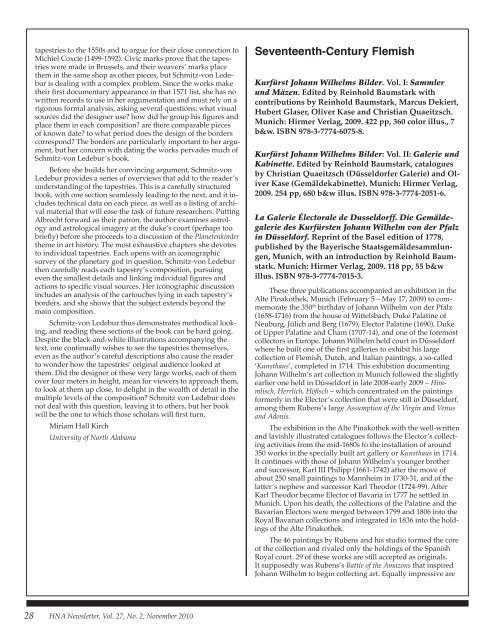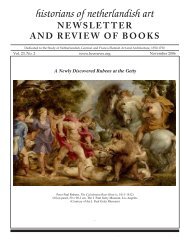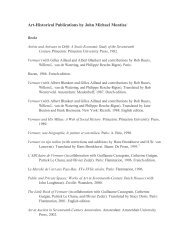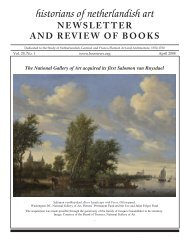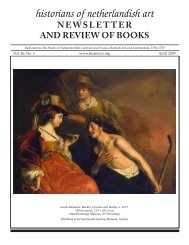newsletter - Historians of Netherlandish Art
newsletter - Historians of Netherlandish Art
newsletter - Historians of Netherlandish Art
Create successful ePaper yourself
Turn your PDF publications into a flip-book with our unique Google optimized e-Paper software.
tapestries to the 1550s and to argue for their close connection to<br />
Michiel Coxcie (1499-1592). Civic marks prove that the tapestries<br />
were made in Brussels, and their weavers’ marks place<br />
them in the same shop as other pieces, but Schmitz-von Ledebur<br />
is dealing with a complex problem. Since the works make<br />
their fi rst documentary appearance in that 1571 list, she has no<br />
written records to use in her argumentation and must rely on a<br />
rigorous formal analysis, asking several questions: what visual<br />
sources did the designer use? how did he group his fi gures and<br />
place them in each composition? are there comparable pieces<br />
<strong>of</strong> known date? to what period does the design <strong>of</strong> the borders<br />
correspond? The borders are particularly important to her argument,<br />
but her concern with dating the works pervades much <strong>of</strong><br />
Schmitz-von Ledebur’s book.<br />
Before she builds her convincing argument, Schmitz-von<br />
Ledebur provides a series <strong>of</strong> overviews that add to the reader’s<br />
understanding <strong>of</strong> the tapestries. This is a carefully structured<br />
book, with one section seamlessly leading to the next, and it includes<br />
technical data on each piece, as well as a listing <strong>of</strong> archival<br />
material that will ease the task <strong>of</strong> future researchers. Putting<br />
Albrecht forward as their patron, the author examines astrology<br />
and astrological imagery at the duke’s court (perhaps too<br />
briefl y) before she proceeds to a discussion <strong>of</strong> the Planetenkinder<br />
theme in art history. The most exhaustive chapters she devotes<br />
to individual tapestries. Each opens with an iconographic<br />
survey <strong>of</strong> the planetary god in question. Schmitz-von Ledebur<br />
then carefully reads each tapestry’s composition, pursuing<br />
even the smallest details and linking individual fi gures and<br />
actions to specifi c visual sources. Her iconographic discussion<br />
includes an analysis <strong>of</strong> the cartouches lying in each tapestry’s<br />
borders, and she shows that the subject extends beyond the<br />
main composition.<br />
Schmitz-von Ledebur thus demonstrates methodical looking,<br />
and reading these sections <strong>of</strong> the book can be hard going.<br />
Despite the black-and-white illustrations accompanying the<br />
text, one continually wishes to see the tapestries themselves,<br />
even as the author’s careful descriptions also cause the reader<br />
to wonder how the tapestries’ original audience looked at<br />
them. Did the designer <strong>of</strong> these very large works, each <strong>of</strong> them<br />
over four meters in height, mean for viewers to approach them,<br />
to look at them up close, to delight in the wealth <strong>of</strong> detail in the<br />
multiple levels <strong>of</strong> the composition? Schmitz von Ledebur does<br />
not deal with this question, leaving it to others, but her book<br />
will be the one to which those scholars will fi rst turn.<br />
Miriam Hall Kirch<br />
University <strong>of</strong> North Alabama<br />
28 HNA Newsletter, Vol. 27, No. 2, November 2010<br />
Seventeenth-Century Flemish<br />
Kurfürst Johann Wilhelms Bilder. Vol. I: Sammler<br />
und Mäzen. Edited by Reinhold Baumstark with<br />
contributions by Reinhold Baumstark, Marcus Dekiert,<br />
Hubert Glaser, Oliver Kase and Christian Quaeitzsch.<br />
Munich: Hirmer Verlag, 2009. 422 pp, 360 color illus., 7<br />
b&w. ISBN 978-3-7774-6075-8.<br />
Kurfürst Johann Wilhelms Bilder: Vol. II: Galerie und<br />
Kabinette. Edited by Reinhold Baumstark, catalogues<br />
by Christian Quaeitzsch (Düsseldorfer Galerie) and Oliver<br />
Kase (Gemäldekabinette). Munich: Hirmer Verlag,<br />
2009. 254 pp, 680 b&w illus. ISBN 978-3-7774-2051-6.<br />
La Galerie Électorale de Dusseldorff. Die Gemäldegalerie<br />
des Kurfürsten Johann Wilhelm von der Pfalz<br />
in Düsseldorf. Reprint <strong>of</strong> the Basel edition <strong>of</strong> 1778,<br />
published by the Bayerische Staatsgemäldesammlungen,<br />
Munich, with an introduction by Reinhold Baumstark.<br />
Munich: Hirmer Verlag, 2009. 118 pp, 55 b&w<br />
illus. ISBN 978-3-7774-7015-3.<br />
These three publications accompanied an exhibition in the<br />
Alte Pinakothek, Munich (February 5 – May 17, 2009) to commemorate<br />
the 350th birthday <strong>of</strong> Johann Wilhelm von der Pfalz<br />
(1658-1716) from the house <strong>of</strong> Wittelsbach, Duke Palatine <strong>of</strong><br />
Neuburg, Jülich and Berg (1679), Elector Palatine (1690), Duke<br />
<strong>of</strong> Upper Palatine and Cham (1707-14), and one <strong>of</strong> the foremost<br />
collectors in Europe. Johann Wilhelm held court in Düsseldorf<br />
where he built one <strong>of</strong> the fi rst galleries to exhibit his large<br />
collection <strong>of</strong> Flemish, Dutch, and Italian paintings, a so-called<br />
‘Kunsthaus’, completed in 1714. This exhibition documenting<br />
Johann Wilhelm’s art collection in Munich followed the slightly<br />
earlier one held in Düsseldorf in late 2008-early 2009 – Himmlisch,<br />
Herrlich, Höfi sch – which concentrated on the paintings<br />
formerly in the Elector’s collection that were still in Düsseldorf,<br />
among them Rubens’s large Assumption <strong>of</strong> the Virgin and Venus<br />
and Adonis.<br />
The exhibition in the Alte Pinakothek with the well-written<br />
and lavishly illustrated catalogues follows the Elector’s collecting<br />
activities from the mid-1680s to the installation <strong>of</strong> around<br />
350 works in the specially built art gallery or Kunsthaus in 1714.<br />
It continues with those <strong>of</strong> Johann Wilhelm’s younger brother<br />
and successor, Karl III Philipp (1661-1742) after the move <strong>of</strong><br />
about 250 small paintings to Mannheim in 1730-31, and <strong>of</strong> the<br />
latter’s nephew and successor Karl Theodor (1724-99). After<br />
Karl Theodor became Elector <strong>of</strong> Bavaria in 1777 he settled in<br />
Munich. Upon his death, the collections <strong>of</strong> the Palatine and the<br />
Bavarian Electors were merged between 1799 and 1806 into the<br />
Royal Bavarian collections and integrated in 1836 into the holdings<br />
<strong>of</strong> the Alte Pinakothek.<br />
The 46 paintings by Rubens and his studio formed the core<br />
<strong>of</strong> the collection and rivaled only the holdings <strong>of</strong> the Spanish<br />
Royal court. 29 <strong>of</strong> these works are still accepted as originals.<br />
It supposedly was Rubens’s Battle <strong>of</strong> the Amazons that inspired<br />
Johann Wilhelm to begin collecting art. Equally impressive are


